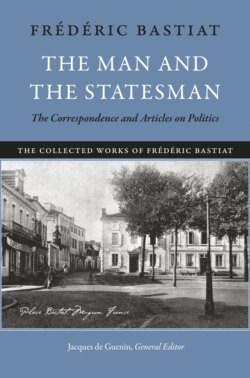Читать книгу The Man and the Statesman - Bastiat Frédéric - Страница 7
На сайте Литреса книга снята с продажи.
ОглавлениеGeneral Editor’s Note
The Collected Works of Frédéric Bastiat will be the most complete edition of Bastiat’s works published to date, in any country or in any language. The main source for this translation is the Œuvres complètes de Frédéric Bastiat, published by Guillaumin et Cie. in the 1850s and 1860s.1 The additional sources used in this edition are the following: Lettres d’un habitant des Landes, Frédéric Bastiat, collected by Mme Cheuvreux (Paris: Quantin, 1877); articles published in La Chalosse, a local newspaper of the Landes, an area, or département, in southwestern France where Bastiat spent most of his life; articles published in La Sentinelle des Pyrénées, a newspaper printed in Bayonne; and various unpublished letters or articles gathered by the historian Jean-Claude Paul-Dejean, a Bastiat scholar, who has also collaborated in writing the introduction to this volume and the notes of the whole edition.
Although the Guillaumin edition was generally chronological, the volumes in this series have been arranged thematically:
The Man and the Statesman: The Correspondence and Articles on Politics
“The Law,” “The State,” and Other Political Writings, 1843-1850
Economic Sophisms and “What Is Seen and What Is Not Seen”
Miscellaneous Works on Economics: From “Jacques-Bonhomme” to Le Journal des Économistes
Economic Harmonies
The Struggle Against Protectionism: The English and French Free-Trade Movements
The initial Guillaumin edition of the Œuvres complètes, published shortly after Bastiat’s death, comprised six volumes. Later on, Prosper Paillottet, Bastiat’s editor and executor, inherited a number of unpublished letters and articles, some of which were drafts, sometimes not even complete, but always meaningful enough to be of interest. After due consultation with Bastiat’s intellectual friends, including Richard Cobden, Paillottet decided to publish everything in a seventh volume. The drafts themselves were regrouped under the heading ébauches (drafts), and this volume contains some of them.
There are three kinds of notes in this edition: footnotes by the editor of the Guillaumin edition (Prosper Paillottet), which are preceded by “(Paillottet’s note)”; new editorial footnotes to this edition, which stand alone (unless they are commenting on Paillottet’s notes, in which case they are in square brackets following Paillottet’s note); and source notes, which are given in the last line of the heading for each letter or article. For those items taken from the Œuvres complètes, which constitutes the source for the majority of the items, the source note consists of the volume number and the beginning page number2 plus any additional source information if the item has been previously published in a journal or similar publication.
In the text, Bastiat (and Paillottet in the notes) makes many passing references to his works, for which we have provided an internal cross-reference if the work is found in this volume. For those works not in this volume, we have provided the location of the original French version in the Œuvres complètes (indicated in a footnote by “OC,” followed by the Guillaumin volume number, beginning page number, and French title of the work).
In addition, we have made available two online sources3 for the reader to consult. The first source is a table of contents of the seven-volume Œuvres complètes and links to PDF facsimiles of each volume. The second source is our “Comparative Table of Contents of the Collected Works of Frédéric Bastiat,” which is a table of contents of the complete Liberty Fund series. Here, the reader can find the location of the English translation of the work in its future Liberty Fund volume. These contents will be filled in and updated as the volumes come out and will eventually be the most complete comparative listing of Bastiat’s works.
In order to avoid multiple footnotes and cross-references, three glossaries have been provided for the identification of the persons, places, and subjects and terms mentioned in the text that were important to Bastiat in his time. The glossaries also provide historical context and background for the reader as well as a greater understanding of Bastiat’s work. If a name as it appears in the text is ambiguous or is in the Glossary of Persons under a different name, a brief footnote has been added to the text to identify the name as it is listed in the glossary.
It should be remembered that when the Guillaumin edition was issued a number of people who knew Bastiat personally were still alive. The ellipses added by Paillottet, which precede or end some letters and which signal the omission of expressions of politeness or affection, have been reproduced in this edition. Ellipses are also used to indicate either a missing portion of the drafts or a deliberate cut by Paillottet when he thought that the passage in question was too private in nature. Finally, original italics as they appear in the Guillaumin edition have been retained.
Jacques de Guenin Saint-Loubouer, France
